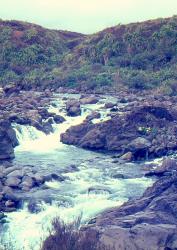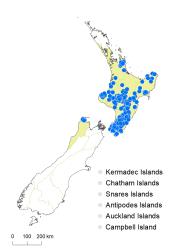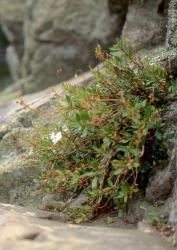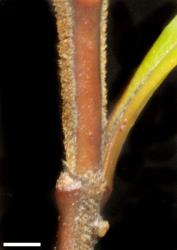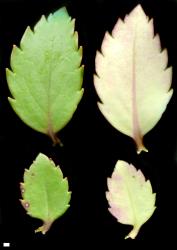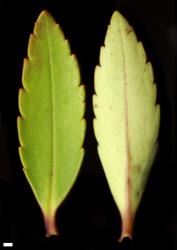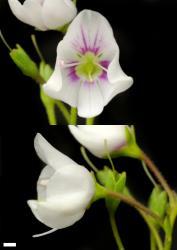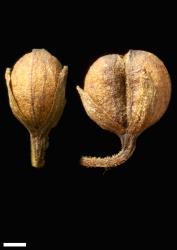- ≡ Veronica catarractae var. lanceolata (Benth.) Hook.f., Bot. Antarct. Voy. II. (Fl. Nov.-Zel.) Part I, 195 (1853)
- ≡ Parahebe catarractae subsp. lanceolata (Benth.) Garn.-Jones in Garnock-Jones & Langer, New Zealand J. Bot. 18: 294 (1980)
- ≡ Parahebe lanceolata (Benth.) Garn.-Jones in Garnock-Jones & Lloyd, New Zealand J. Bot. 42: 203 (2004)
- = Veronica diffusa Hook.f. in Hooker, Icon. Pl. 7, t. 645 (1844) nom. illeg., non Veronica diffusa Raf. 1838
- ≡ Veronica catarractae var. diffusa Hook.f., Handb. New Zealand Fl. 216 (1864) nom. nov. pro Veronica diffusa Hook.f. 1844
- ≡ Parahebe diffusa (Hook.f.) W.R.B.Oliv., Rec. Domin. Mus. 1: 230 (1944)
- ≡ Parahebe catarractae subsp. diffusa (Hook.f.) Garn.-Jones, New Zealand J. Bot. 18: 292 (1980)
- = Veronica lanceolata var. angustifolia Benth. in de Candolle, Prodr. 10 463 (1846)
- = Veronica irrigans Kirk, Trans. New Zealand Inst. 2: 94 (1870)
Sub-shrub to 0.45 m tall. Stems prostrate to erect, eglandular-pubescent or glabrous; hairs bifarious, rarely uniform. Leaf bud indistinct; leaves separating while very small, opposite-decussate, or sub-distichous on prostrate stems, erecto-patent to spreading or recurved; lamina sub-coriaceous or coriaceous, linear, lanceolate, ovate, elliptic, orbicular, rhomboid, or deltoid, rarely obovate or oblanceolate, 5–100 mm long, 1.5–25.0 mm wide, dull or glossy pale to dark green above, dull pale green or green or pinkish beneath; midrib and sometimes secondary veins evident; surfaces glabrous, sometimes with eglandular hairs along midrib above; margins glabrous, serrate; teeth in 1–15 pairs; apex sub-acute to acuminate, rarely obtuse; base cuneate, truncate, or sub-cordate; petiole 1–6 mm long. Inflorescence a lateral raceme, 30–350 mm long; flowers distant, 4–30, all bisexual; bracts alternate, linear, lanceolate, elliptic, ovate, or narrowly deltoid, < pedicels; pedicels erecto-patent, incurved at fruiting, 5–25 mm long, eglandular-hairy all around, rarely glabrous or glandular-hairy. Calyx lobes 4, obtuse to acuminate, 2–4 mm long, sub-equal, glandular- and/or eglandular-ciliate, occasionally pubescent on abaxial surfaces. Corolla 8–15 mm diameter; tube white and yellow, 0.5–1.5 mm long, < calyx, eglandular-hairy inside; lobes white, usually 4 or rarely 5 by division of posterior lobe, erecto-patent to spreading, unequal, narrowly oblong or elliptic to orbicular, 3.5–8.0 mm long, rounded, sometimes posterior emarginate; nectar guides magenta. Stamen filaments white, 2–4 mm long; anthers pink or magenta. Style glabrous, 3.5–7.0 mm long. Capsules angustiseptate to turgid, emarginate, glabrous, 2.5–4.5 mm long, 2.5–4.0 mm at widest point. Seeds discoid to obovoid, flattened, smooth, straw-yellow to brown, 0.5–1.1 mm long.
V. lanceolata is a highly variable species, and some of the regional variants can be hard to distinguish from other species in the speedwell hebe group.
Large plants with coarsely toothed leaves may resemble V. catarractae, but that species is endemic to Fiordland and can be distinguished by its white leaf undersides and pedicel hairs in a single row.
Smaller low-growing plants with broader leaves can resemble V. melanocaulon, which is endemic to Marlborough and can be distinguished by usually obovate or oblanceolate leaves, usually glabrous or sometimes glandular inflorescences, and very dark purplish-black stems that contrast with the pale green petioles.
Small plants with short, broad leaves may resemble V. lyallii, but V. lyallii plants have shorter inflorescences, more rounded leaf teeth, and markedly arcuate, antrorse stem hairs; sometimes their flowers lack nectar guides and their leaves can be bronze-green. V. lyallii is confined to the South Island.
North Island: Auckland (Coromandel Peninsula, Pirongia), Taranaki from Herangi Range to Kaitake Range), Gisborne, Volcanic Plateau, Southern North Island.
South Island: Western Nelson (Wakamarama Range only).
Rock outcrops, especially on stream and river banks, rooted in silt in crevices, also on cliffs, ledges, and screes. Recorded elevations range from 10 to 1708 m.
Garnock-Jones & Lloyd (2004) considered that plants with broad leaves and densely glandular inflorescences from mountains of the Volcanic Plateau might be the result of introgression with V. hookeriana. Similarly, plants on Mt Hikurangi and the Maungaharuru Range appear to intergrade with local forms of V. hookeriana to some extent.
Flowers: November–March; fruits: January–May, and old fruits present year round.
2n = 42 (Garnock-Jones & Langer 1980, as Parahebe catarractae). Hair reported the same number (as Parahebe catarractae) from a cultivated plant of unknown origin and a plant from Mt Ruapehu that I have identified as V. hookeriana × lanceolata.
Veronica lanceolata is classified in V. subg. Pseudoveronica sect. Hebe (Albach & Meudt 2010). Molecular phylogenetics (Albach & Meudt 2010) placed V. lanceolata firmly within the speedwell hebe clade, along with other species of Veronica that are characterised by lax inflorescences, short corolla tubes, nectar guides, plicate lateral corolla lobes, attenuate stamen filament bases, and turgid capsules, but the internal relationships within that clade are not clearly established.
Garnock-Jones & Lloyd (2004) described nine regional races in detail. These were not treated formally as subspecies or varieties because they are not clear-cut, tend to vary within and among populations, and overlap with each other in their morphological features.
(See: Regional variation in Veronica lanceolata)
Region | Stems | Leaf shape & size (mm) | Leaf apex | Leaf base | Pairs of teeth | Flower number | Inflorescence hairs | Bracts | Pedicel length & hairs | Calyx hairs |
|---|---|---|---|---|---|---|---|---|---|---|
Coromandel, Taranaki, Paturau (NW Nelson) | ascending to erect; internodes 5–25 mm long; bifarious (rarely glabrous) | linear to lanceolate, 20–100 x 1.5–12 mm | acute to acuminate | cuneate | (3–) 6–15 | 9–30 | glabrous or eglandular | linear or lanceolate, glabrous or ciliate | 5–13 mm, eglandular or glandular all around | glabrous or ciliate |
N Taranaki, Whanganui mudstone | stout, decumbent to erect; internodes 10–90 mm long; glabrous (rarely bifarious) | lanceolate, ovate, or elliptic, 15–80 x 8–35 mm | acute to acuminate | cuneate to cordate | (7–) 10–18 | 20–35 | glabrous or eglandular | lanceolate or narrow elliptic, glabrous or ciliate | 8–18 mm, eglandular all around or sometimes glandular | margins or adaxial surface, eglandular or glandular |
Volcanic Plateau | slender to stout, decumbent to erect; internodes 5–70 mm long; bifarious or glabrous | lanceolate, ovate, or elliptic, 8–45 x 3–25 mm | acute or subacute | cuneate to cordate | (3–) 6–10 | 8–30 | eglandular sometimes mixed with glandular | lanceolate, elliptic, or ovate | 8–20 mm, eglandular and/or glandular all around | glabrous, or marginal, or abaxial, eglandular or glandular |
East Cape, Kaimanawa, Kaweka, and Ruahine Ranges | slender to stout, prostrate to erect; internodes 5–70 mm long; bifarious, or rarely uniform | lanceolate to oblanceolate, elliptic, or ovate to obovate, 3–50 x 1.5–22 mm | subacute to acuminate | cuneate or subcordate | (2–) 4–9 (–12) | 5–25 | eglandular, rarely some glandular hairs (Maungaharuru Range) | lanceolate to narrowly elliptic | 8–25 mm, eglandular all around (rarely some glandular (Maungaharuru Range)) | glabrous or eglandular on margins |
Lowland Hawke’s Bay & eastern Bay of Plenty | stout, ascending to erect; internodes 5–40 mm long, bifarious | lanceolate or elliptic, 5–55 x 3–15 mm | subacute to acute | cuneate | 4–11 | 5–25 | eglandular, sometimes also glandular; peduncle may be glabrous | lanceolate or elliptic | 7–16 mm, eglandular or mixed eglandular & glandular all around | glabrous or eglandular on margins |
Tararua & Aorangi Ranges (alpine) | moderately stout, decumbent to ascending; internodes 5–25 mm long, bifarious | ovate or elliptic, rarely lanceolate, 10–25 x 5–20 mm | subacute | subcordate to cordate, rarely abruptly cuneate | (3–) 6–12 | 8–20 | eglandular and glandular | lanceolate or elliptic | 6–9 (–11) mm, eglandular or glandular all around | glabrous or eglandular on margins |
Tararua Range (lowland); similar plants at Kaituna R., NW Nelson | slender to stout, ascending to erect; internodes 3–35 mm long, bifarious | linear, lanceolate, oblanceolate, or elliptic, 7–40 x 2–13 mm | narrowly acute to subacute | cuneate | 3–8 (–12) | 6–20 | eglandular, sometimes also glandular; peduncle may be glabrous | lanceolate, rarely elliptic | (5–) 8–12 mm, eglandular or mixed eglandular & glandular all around | marginal, eglandular or mixed eglandular & glandular, rarely glabrous |
Southern Hawke’s Bay & lowland Wairarapa | very slender prostrate to decumbent; internodes 5–30 mm long, bifarious | lanceolate or oblanceolate to broadly elliptic, 5–20 x 2.5–10 mm | subacute or acute | cuneate | 2–6 | 4–8 (–12) | eglandular (peduncle glabrous) | elliptic | 6–10 mm, eglandular all around, rarely glabrous | marginal eglandular, or glabrous |
Rimutaka Range & Cape Palliser | stout, ascending to erect; internodes 8–70 mm long, bifarious | broadly ovate or elliptic, 8–30 x 7–25 mm | obtuse to subacute | cuneate, truncate, or cordate | (4–) 6–9 (–12) | 6–15 (–30) | mixed eglandular & glandular, peduncle glabrous | elliptic | 8–12 mm, eglandular all around (glandular at C. Palliser) | glabrous or rarely 1–2 hairs at apex |



